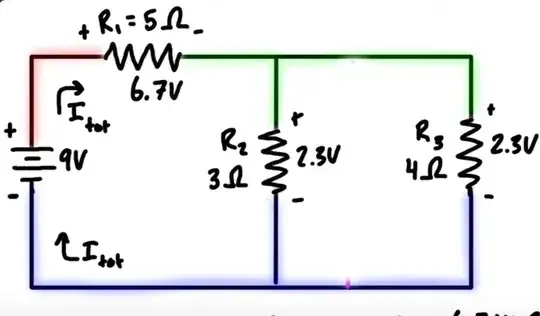Perhaps a revision of some of your statements is in order. You said:
My understanding of voltage is that it is the amount of energy needed to move an electrical charge across 2 points in the circuit.
Correct, but easy to misinterpret. The truth is that any voltage will eventually move a charge from one place in a circuit to another. What changes is the rate at which charges complete that journey.
the larger the resistor the more energy needed to move current through
Very misleading. Voltage is a measure of energy that a charge would have to lose on a complete journey through the resistance. That doesn't mean that you can't have quadrillions of charges moving only part way through it, losing only a small chunk of their energy.
Current is a measure of how many charges are entering or leaving the resistor each second, and is not to be confused with how many charges are completing the entire journey through the resistor. Probably no single charge will make the complete journey, unless you leave that current flowing for a long time.
With the two resistors on the right, I would think that the larger resistor would have a greater voltage across it, but it's the same as the other parallel resistor according to KVL
The voltage across each resistor R2 and R3 is indeed the same according to KVL, but...
If you have a larger resistor, wouldn't you need more energy to move a charge through it? How could it be the same as the smaller resistor?
It is correct to say that with the same voltage across them, the difference between the potential energy of a charge found at one end of R2/R3, and the potential energy of a charge found at the other end, is the same. That is, in both cases, a charge that completes the journey via either resistor will have lost the same amount of energy after a complete journey through its respective resistor.
However, again it's not correct to say that any charge makes that complete journey. All else being equal (resistor dimensions, cross-section area, charge density etc), the average speed of individual charges through the 3Ω resistor will slightly greater than (by a factor of \$\frac{4}{3}\$) than the average speed of charges in the 4Ω resistor.
Consequently, more charges are entering the top of R2 each second (and leaving at the bottom), than are entering (and leaving) R3 each second. This is the definition of current: quantity of charge passing some point in one second.
It would be correct to say that after a long, long time, \$\frac{4}{3}\$ as many charges will have completed the journey through R2 compared to charges travelling through R3.
Instantaneously, that picture doesn't work, because in a tiny fraction of a second, no single charge has time to complete the journey. Yet current is still flowing, and is non-zero. I repeat, that's because there are quadrillions of charges travelling part-way, rather that just a few making it all the way through.
Your interpretation of voltage is correct, though, just don't forget that a charge that moves only, say, half way between two points of potential difference (half way through the resistor) will only lose half of its potential energy, but it still moved, and it still contributed to current! There's always another charge that started half-way, and made it out of the resistor!
Just extend that description of behaviour to quadrillions of charges, each moving only a tiny distance in each second, and you'll get a better picture of what's going on.

nodesof the circuit as you did. Handy. Think of each colored node as a solid bar of copper with an untold number of free electrons in an ocean. There simply cannot be any voltage differences in that solid copper bar. If there were any voltage difference at all, one place to another, then electrons would move accordingly, and instantly, such that there was no remaining difference anywhere in that sea. There just cannot be any voltage difference of any size for any time there. It just doesn't happen. It can't. Now, is just that muchintuitiveto you? – periblepsis Feb 26 '24 at 00:41self-leveling. I'm wanting you to focus on this idea because if it makes sense to you and you can hold it in mind, then you must also see that there cannot be any voltage difference across those two resistors you mentioned. It's just not possible. So this means there is a contradiction in ideas here. If you accept my thought, then you must reject yours. They cannot be simultaneously true. So think about it for a moment. – periblepsis Feb 26 '24 at 00:44